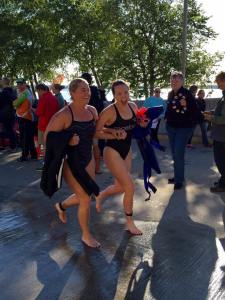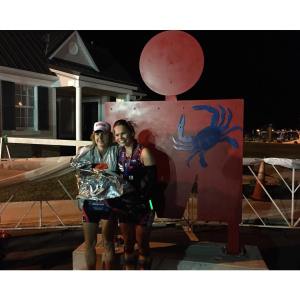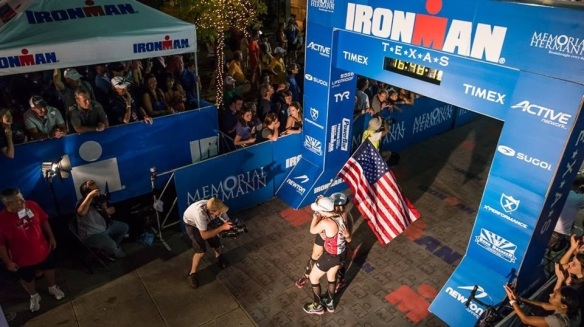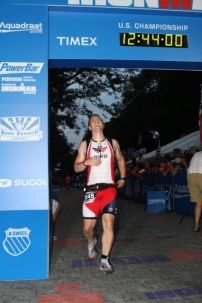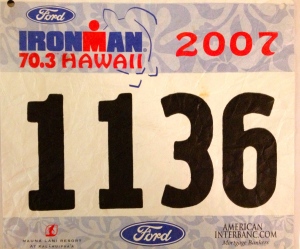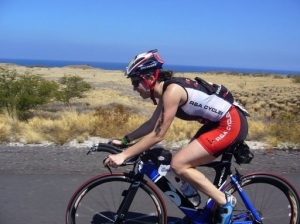Last fall, Rachel Weeks and I decided to race Ironman Wisconsin together in 2015. Rachel and I hadn’t competed in a full IM together since 2013, when we raced Ironman Texas.
Since I guided my first ironman in 2010, I have averaged about one per year, but there was a 2.5 year gap between Texas and Maryland. Some people are under the impression that I do Ironmans all the time, which is simply not the case. I was excited to guide another Ironman, as Rachel and I had so much fun in Texas, but I took a much-needed a break from long races after my move to Texas in July of 2013.
Shortly after Rachel and I decided to race Wisconsin, Tina Ament approached me about competing in an Ironman. She suggested Ironman Maryland, because the course seemed tandem-friendly (not very hilly) and the race was within 2 hours of her home in Alexandrai, VA. Tina was well aware that IMMD and IMWI were close together. We were both a little bit apprehensive about having me guide a second ironman within a month of the first. I wanted to make sure that Tina had the best race she could possibly have- I didn’t want to be impaired after my first IM. I talked to a number of experienced athletes and coaches to see if it was possible to complete two Ironmans in a month and do race them both well.
The general consensus was that I should do basically nothing between the two events. Brad Williams, who is a pro triathlete and the Team RWB Tri Director, said that I might even be stronger for the second race.
I enlisted the help of Jessica Jones Meyers, another incredible pro athlete (who just became a guide for soon to be paralympian, Patricia Walsh). Jessica is an amazing coach and I trusted that she could help me prepare for both races.
After four months of dedicated ironman training (I focused on training for bike races throughout the winter/spring before I switched to IM training), Wisconsin race week arrived. The month leading up to Wisconsin was intense. After a work trip to DC, I guided Rachel in a half IM in Michigan and Ashley Eisenmenger in the Chicago Triathlon.
I didn’t want to taper for too long, as I knew I would have a three week taper between the two races.
Ironman Wisconsin
I was so excited to meet up with Rachel in Chicago, to start our drive to Madison. Rachel is such a wonderful woman. She’s the mother of two young girls and is an advocate for vision/hearing impaired athletes. She has been living with Ushers Syndrome since the age of 19 and became the first vision/hearing impaired athlete to complete an IM in 2013.
Leading up to Texas in 2013, neither Rachel nor I were training as well as we should have been. The fact that we finished the race within the time limit was really incredible, given how rough our training had been and due to the oppressive heat. I think that both Rachel and I wanted to have a really strong race in Wisconsin. We both put the work in and we knew we could PR by a significant amount.
On race morning, I felt good. I had been surprised by my good friend Ashley, who got her dad to drive her up from Tolono, IL (I don’t know where it is, either). Danny Craven, a fellow Team RWB member and guide, helped coordinate the surprise. I have never been more excited the morning of a race!!!
Swim
Rachel and I got to start the swim 10 minutes ahead of the able bodied age-group athletes, which is pretty standard in Ironman races.
The 10 minute head start gives us an opportunity to find a rhythm, but it also means that we get passed by the majority of the field at some point in the race. When I’m guiding, I love those first 10 minutes, though it is a little nerve wracking to watch a wall of 2000 ironman athletes swimming towards us when after the age-group gun goes off. We had almost made it to the first buoy when the fastest swimmers caught up to us.
When we turned around the first buoy (Where everyone starts mooing. Because, Wisconsin), we were in the thick of it. Wisconsin had one of the most aggressive fields of athletes I’ve ever experienced. Rachel handled the swim like an absolute champ. She didn’t let the people elbowing her in the face distract her during the swim. In fact, on a couple of occasions, she popped her head out of the water and laughed out loud!
It wasn’t as fast of a swim as we thought it might be. Some swim courses are like that- no matter how strong you feel, you just don’t go as fast as you think you’re going.
We got out of the swim in under two hours and were all smiles.
After running up the helix and doing a full change into Tri kits in transition, we were ready to hit the bike course.
Bike
Both Rachel and I love the bike. I knew that Madison had reputation for having the hardest/slowest ironman bike course, but I kept hoping that the athletes reviewing the race were exaggerating. I mean, every ironman is hard, right?
No one exaggerated. Wisconsin’s bike was brutal.
Rachel’s bike had some issues shifting into the easy ring at the beginning of the ride, so we had to stop for mechanical assistance a couple of times. I don’t think it cost us too much time, but it certainly was frustrating.
20 miles into the bike, we were averaging 14-15 miles an hour. I found out later that both Rachel and I were about to lose it. I’ve never wanted to drop out of an ironman bike course before, but the thought crossed my mind more than a few times in Wisconsin. The first 3/4 of the first loop felt like a terrible false flat. Any time there was a downhill, the course would turn sharply, so we couldn’t even enjoy the momentum advantage we get on a tandem.
The end of each loop of the bike includes three steep climbs, appropriately called “The Three Bitches.”
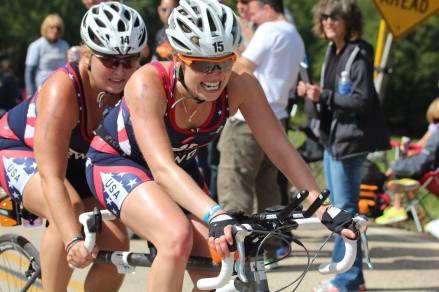
Suffering on the “three bitches”.
The good thing about the climbs is that spectators line the course. It feels like a European bike race, or like crybaby hill (for those of you who have done Tulsa Tough). We saw Danny and Ashley on the third hill, which provided us with some much needed motivation. I’ve never felt Rachel push so hard. She was on a mission!!! It was incredible.
I felt better going into the second loop. I knew we would make the time cutoff for the bike, assuming nothing else went wrong.
Then, something went wrong. At mile 75 or so, our bike chain snapped. That was a mechanical issue I couldn’t fix myself. Thankfully, the chain that broke was of normal length, so the mechanics would at least have a chance to try and fix it.
Unfortunately, because it was getting later in the day, the mechanics were helping other people out on the course. We had a marshal radio for help and proceeded to wait for about 20 minutes for help. The mechanics in Wisconsin were awesome. They were helpful, fast, and friendly. As soon as they had a chance to get to us, they grabbed a brand new chain and put it on the bike.
We didn’t have to drop out!!! I was so relieved to be able to continue with the race, it didn’t even matter that my legs were absolutely trashed. I love Rachel’s attitude. She could have just thrown up her hands when the chain broke, but she was patient and focused. I knew she would become an ironman for the second time, at the end of the day.
We suffered through the rest of the ride. I’ve never been so happy to get off of a bike in my life. Rachel cried with relief when we finally got to transition.
Run
When you get o
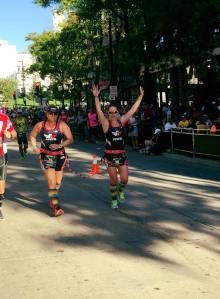
ff the bike in an ironman, the best feeling is knowing that your equipment can’t break any more. We knew our legs could get us through the marathon.
Rachel and I started out with a 4 min run/1 min walk strategy. We have found that it’s faster than trying to run the whole race and I like the fact that it makes time go by faster.
The Wisconsin run course was wonderful. We got to see tons of our friends out on the course. The energy of the spectators helped carry us through.
Rachel got stronger throughout the marathon. I felt so lucky to be a part of the experience.
We crossed the finish line in 16:35. I am so proud of how the race went. Going into the event, we both thought our time would be faster, but given how tough the course was (including mechanicals), I couldn’t be happier with how it went! The next day, I found myself dreaming about which Ironman we would conquer next.

At the finish of Ironman Wisconsin, with Ironman cheerleader-extraordinaires, Ashley and Danny.
Taper #2
But, I wasn’t done for the year. The day after the race, I flew home to Austin and packed for my next work trip to NYC. I took the entire week off of training, but I basically didn’t stop moving the whole time I was there.
So, when I got back to Austin, I focused on sleeping and resting.
There were 21 days between Wisconsin and Madison. I had a taper in place, thanks to Jessica. I felt ready to go.
When Maryland race week rolled around, we started hearing reports of hurricane Joaquin… There’s no way it would affect Maryland, right? Wrong.
The Wednesday before the race, the race director decided to cancel the event. They tentatively planned to hold an alternate race on 10/17 (two weeks after the original race), but there were no guarantees.
I immediately got on the phone with Tina. We started trying to figure out what our best course of action would be. Tina’s attitude was awesome. Tina is an incredibly accomplished ironman triathlete/endurance athlete. Last year, she became the first blind female to compete the Ironman World Championship in Hawaii and a month before Maryland, she crushed a 12 hour bike race. Tina makes me feel lazy!
We discussed possibly racing Florida or Arizona, but that would mean waiting another month to race. Ultimately, we decided to proceed as though the backup race were going to happen. The biggest challenge for me was figuring out how to un-taper and then re-taper for the race. I felt like I hadn’t done anything (except one ironman) for over a month. So, Jessica figured out a plan for me to ramp up training for a week and then taper again.
One unexpected bonus

On the Congress Street Bridge, after Kelly hit the 100 mile mark. What a great day!
was getting to accompany my good friend, Kelly Krause, on her first century. I’m so glad that I was able to be a part of such an important day for Kelly! Riding with her and my friend, John Montesi, infused me with positive energy and helped power me through the rest of my training/taper until Ironman Maryland.
Ironman Maryland
Finally, race week (take 2) arrived. I’m really grateful to work for a company that understands and supports my racing schedule. A lot of people assume I don’t work, or that I get paid to guide. Neither of these things are true. I have a job in finance that I love and I have never made any money coaching or guiding athletes. I tend not to take actual vacations, because I spend so many vacation days racing, but that’s a decision I’m happy with. Some people want to sit on a beach and relax, I’d rather race an ironman as a guide.
I met Tina and Pamela Ferguson at Reagan International Airport in DC the Thursday before IMMD. Pamela is a super strong, Houston-based cyclist, who is perhaps the best cheerleader I’ve ever met. She welcomes everyone into the cycling and is beyond generous with her time and energy. I was so grateful that she was part of our race crew for the weekend. Also, Tina and Pamela are teaming up to race Ironman 70.3 Longhorn in Austin on November 8th. I absolutely cannot wait to cheer them on!
Tina and I met in 2010 and have raced together in a number of events, including 2 Ironmans. Tina is a true friend. She’s supported me through some really tough times in my life, without judgment or reservation. She’s the kind of person who will show up at the finish line of Race Across America at 2am to watch you finish. Yes, Tina showed up in Bethesda in 2012 and surprised me at the finish line of RAAM. I hope everyone who’s reading this has a friend like Tina.
The drive to Cambridge took a long time; there was no way to make it to packet pick up on Thursday. We settled into our home stay, grabbed some dinner and went to bed.
Friday was a whirlwind. We registered without any issues, but soon learned that Pamela’s bike had not arrived from Houston. Tri Bike Transport (TBT) does an amazing job transporting bikes to races, but with the confusion surrounding hurricane Joaquin, Pamela’s bike was lost in the shuffle. Thankfully, TBT offered to have an employee drive a sweet demo bike up from North Carolina. The only catch was that Pamela would not get to see, let alone ride, the new bike until race morning. Pamela was an absolute champ. Her attitude about the whole experience was amazing. She prepped as much of her stuff as she could and just went with the flow.
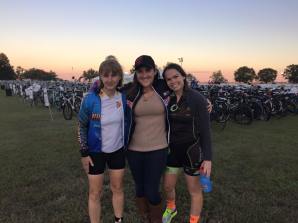
In transition with Tina and Pamela, after dropping off our gear bags.
Every time I race with an athlete, I have to adjust my position on the tandem bike to make sure it fits me. I always worry that I will mess up my bike fit and have to stop and change my saddle position during a race. Imagine how bad a poorly positioned saddle would feel after 4 hours of riding… I thought about how Pamela was riding a completely new bike in her race, and I stopped stressing out. I had no right to complain!Swim
The morning of the race was freeeeezing. I think I was most nervous about how I would stay warm on the bike. Since I moved to Texas, I have completely lost my ability to tolerate cold weather. I know, I know… I’ve gotten soft.
The wind was intense when we got to the swim start. The announcer indicated that the course might change, so we huddled together in our sweatshirts and waited to see what would happen. After announcing that the swim would be cut in half (this news was met with cheers from the crowd), the officials finally decided to shorten the course to 1.89 miles, rather than 1.2.
Tina and I lined up at the start and I tried to figure out what the new course looked like. I was still trying to get a handle on where I was supposed to go, when we were ushered into the water.
I’ve mentioned the fact that PC athletes normally get a 10 minute head start in Ironman races. It seemed like this time would be no different. I imagined that the time between our start and the start of the fastest men (Maryland had a self-seeded wave start) might be a little shorter than 10 minutes, due to the race’s delayed start time, but I was not prepared for what happened next.

Swim start on the boat ramp.
Tina and I hadn’t even made it past the boat launch, when the first wave of swimmers began their race. The effect was a bottleneck of swimmers all vying for the best position heading toward

s the first turn buoy. All of a sudden, we were surrounded by ridiculously strong athletes, trying desperately to get past us. I cannot imagine how that experience felt to Tina. But I was blown away by how well she handled the chaos. After a few minutes, we were able to figure out a good line to take and got into a good rhythm.
*I should note that the announcer found us after the race and apologized for what happened at the start. He was not expecting the age groupers to go off as soon as they did and said he was “so relieved” when he saw us exit the water. I thought it was very kind of him to apologize.
I’ve never had a better swim with Tina. She finished the course as strong as she was when she started. Pacing is a challenge for most athletes and it can be even harder to determine what speed to swim when you’re battling for position with a bunch of Kona-hopefuls. I couldn’t contain my excitement when we exited the water!
The transition area was a total madhouse. Normally, there are enough chairs for everyone to sit down. In Madison, transition was inside the convention center. It was downright civilized! We ran by the men’s tent and heard volunteers telling male athletes that there was no room and that they would have to change outside. I couldn’t stop laughing!
The women’s tent wasn’t much better. It’s absurdly difficult to change into cycling/triathlon kit when you’re wet. It’s even harder when you’re standing in the middle of a group of half naked women, all digging through their gear bags, trying to change clothes and get out of transition as quickly as possible.
Tina and I decided to wear jackets over our cycling clothes. I changed into full cycling kit, which I don’t normally do, because I was so concerned about the cold. We also wore toe warmers, arm warmers and gloves. The announcer joked the next day that the race director learned that you can hold an Ironman race in the winter! (Ha.)
Bike
Finally, we were out of T1 and onto the bike. I was grateful for a flat course. Tina is a wicked fast cyclist. In May, at Ironman 70.3 Texas, Tina and I posted a 2:28 bike for 56 miles (which translates to just under 23 mph). I didn’t even know that was possible on a tandem!
So, my goal for the ride was to break 6 hours. If conditions were perfect, we wanted to break 5:45, but the wind in Maryland can be intense and unpredictable. It turned out to be a very windy day.

Heading out on the bike at Ironman Maryland.
My Garmin didn’t start working until about 12 miles into the race, which wouldn’t be a huge issue, except that I wasn’t completely sure how much time had passed. I estimated how long we had been riding, by looking at the elapsed time on my watch, but I knew there was some room for error.
It’s hard to maintain intensity and focus during a 112 mile bike. Tina and I worked together to stay on track. I kept her posted on our current speed and tried to break up the race into segments, which can help make the distance more manageable. We were cruising for the first 40 miles or so and then the wind started to pick up.
Thankfully, we both dressed appropriately. I wasn’t cold at all during the ride, but I didn’t take off my arm warmers until our one bathroom break at mile 75 and kept my jacket on the entire ride.
We remained on track (at least, what I estimated was “on track”), for the entire ride, though I knew we didn’t have a ton of room for error. Tina was a blast to ride with. She works her ass off in training and it pays off. Tina really is a force to be reckoned with.
Because Tina has dealt with a number of injuries, she wasn’t confident that her run would be “competitive” (her words, not mine), so I put a lot of pressure on myself to help her get the bike split she wanted. I knew that she would be happy with the race, if we could meet our bike goal.
The course was beautiful, the road was flat, and my legs felt good. I could tell how much effort Tina was putting into the ride, which made me want to work even harder.
I only remember one female cyclist passing us; to our delight, it was Pamela! We passed hundreds of riders on the course and were both psyched about how the race was progressing. There was a strong headwind on the course, but we were able to power through, most of the time.
Towards the end of the ride, the wind kicked up to a degree I had never experienced. At certain points, were riding as hard as we could into the wind and were barely going 15 mph. I desperately begged Tina to give me more, knowing full well that she was going as hard as she could. I think we both wanted to cry at that point.
I kept calling out our speed and letting Tina know that we could still break 6 hours, but that it would be close. I needed every ounce of strength she had. I certainly left everything on the course.
Finally, we got to the bike dismount line. Again, I wasn’t exactly sure how much time had passed, but I was pretty sure that we had broken 6 hours. I took my feet out of my shoes and called for Tina to put her foot down, but I didn’t give as much time to prepare as I should have. Her cleats were stuck in the pedals! I was exhausted from the ride and was caught totally off guard, so I wasn’t able to stop the bike from tipping over when she couldn’t get unclipped.
A volunteer shouted, “What should I do!?” as stepped away from the bike (almost knocking the volunteer over). “I’ve got this!” I yelled, as I reached for Tina’s foot that was still clipped into the pedal. I grabbed her shoe and in one movement, I twisted HARD and heard the “crack” of her cleat breaking free from the pedal.
Within a moment, Tina was up off the ground and we began running towards the bike racks.I found out later that we broke 6 hours by ONE MINUTE. If we had wasted any more time getting unclipped, or taken a slightly longer bathroom break, we wouldn’t have met our goal. I am so proud of the work we did on that course.
Run
Tina and I were in good moods when we began the marathon. We were excited about how the bike felt and we had a huge time cushion; we could have slowly walked the marathon and still broken 17 hours.
The temperature began dropping pretty early on in the marathon. I changed into a dry triathlon kit and kept my arm warmers on. Again, I’ve never worn arm warmers in an ironman. I didn’t take my gloves off the entire run.

All smiles all the time.
Tina kept a steady pace during most of the run. We went with the 4/1 method, like Rachel and I used. Running 26.2 miles is never easy, especially after you’ve already been swimming and biking for 8+ hours. But one major bonus of guiding is that you’re never alone. This can be a drawback, depending on whose company you’re in, but I had a blast racing with Tina.
We always try to cheer other athletes on as we run; it’s fun to make friends throughout the race.
After the sun set, it got even colder. At special needs, we both grabbed the long sleeved shirts we packed, though they didn’t help as much as we wanted.
I was excited to pass by the special needs station because David Trossman, one of the advisors I work with, decided to volunteer at the race after he heard that I was guiding it! I was really touched by the gesture. It was so fun to pass by his station a few times on the run. I always made sure to shout out his name so he wouldn’t miss us. The Ironman Maryland volunteers were absolute troopers. I was frozen during the run- I don’t know how volunteers stayed warm enough all night!
Tina began hurting when we got past the half way mark of the run, but every time I asked her to run, after an aid station or a walk interval, she responded. At one point in the race she turned and said, “You don’t take any shit!” I laughed so hard when she said that! “I thought you knew that already, Tina!,” I responded.
The final hour of the race was challenging. The course was pitch black. I hate running with a head lamp, so I never make it a priority to pack one in special needs. I have decent night vision, but I was certainly straining to see the road ahead of us.
We saw Pamela a couple of times during the run. I knew she wasn’t having her best day, but she always had a huge smile on her face, which makes me love her even more.
Every time we passed Tina’s Team Z teammates, we got a boost of energy. I’ve never seen anything like Team Z’s energy at Ironman races. They are always out in force, until the very end. Thank you, Team Z, over and over again, for your motivation and support.
The last mile of the race was a challenge. Tina had trouble navigating a section of brick road on the course, so we had to walk most of it. It’s incredible how long one mile can feel, after you’ve already traveled close to 140 miles…
Finally, we could see the finish. Tina pushed through the pain and completely dominated Ironman Maryland!!!
We ran across the line holding hands and hugged each other.There is no better feeling than finishing an Ironman. We crossed the line in 14:15. It was Tina’s 3rd fastest Ironman to-date and the fastest Ironman I’ve guided.
The volunteers handed us some warming blankets and we shuffled to the finisher’s tent. The inside of the tent was an interesting site. All of the athletes put on as many articles of clothing as they could find. I had on a scarf that Patricia Walsh knitted for me, a fleece, and my full tri kit. Later, Pamela gave me some spare running tights to wear because I was certain that I wouldn’t be able to survive another minute outside with bare legs.
Obviously, my main priority when we finished the race was finding FOOD. Anyone who knows me, is well aware that I eat constantly. My normal state of being is “hungry.”
That pizza tasted even better than it looks…
My primary goal for Ironman Maryland was to make sure that Tina had an awesome race experience. When she emailed me after the event and said that she was proud of our performance, I was overjoyed. Tina is notoriously hard on herself, so to hear her say that she was proud of a race, surprised and delighted me. Though I know that I am not responsible for how any of my athletes feel about their performance, it can be hard not to feel responsible when a race doesn’t go they way they want.

Tina received an award for her performance in the para division.
Rachel and Tina became Ironman finishers this fall, once again. Finishing 140.6 miles of swimming, biking and running in one day is a massive achievement, no matter how many you’ve done before.
Thank you, Rachel, and thank you, Tina, trusting me to guide you in these challenging races; sharing these experiences with you adds tremendous meaning to my life. I am so glad that I can call both of you my close friends and cannot wait for our next races together!
 ff the bike in an ironman, the best feeling is knowing that your equipment can’t break any more. We knew our legs could get us through the marathon.
ff the bike in an ironman, the best feeling is knowing that your equipment can’t break any more. We knew our legs could get us through the marathon.


 s the first turn buoy. All of a sudden, we were surrounded by ridiculously strong athletes, trying desperately to get past us. I cannot imagine how that experience felt to Tina. But I was blown away by how well she handled the chaos. After a few minutes, we were able to figure out a good line to take and got into a good rhythm.
s the first turn buoy. All of a sudden, we were surrounded by ridiculously strong athletes, trying desperately to get past us. I cannot imagine how that experience felt to Tina. But I was blown away by how well she handled the chaos. After a few minutes, we were able to figure out a good line to take and got into a good rhythm.

